The Effect of Plasma Treatment on the Mechanical Properties of HDPE/Bamboo Fiber Composites
Abstract
1. Introduction
2. Materials and Methods
2.1. Materials and Instruments
2.2. Plasma Treatment of HDPE Surfaces
2.3. HDPE/Bamboo Fiber Composite Material Production
2.4. Surface Wettability Testing and Characterization
2.5. Optimization of Plasma Treatment Parameters and Establishment of Surface Energy Curve Models for Response Surface Method
2.6. Orthogonal Experimental Design for HDPE/Bamboo Fiber Composites
2.7. Testing of Mechanical Properties of HDPE/Bamboo Fiber Composites
2.8. Surface Microstructure Analysis
2.9. X-Ray Diffraction Analysis
2.10. FTIR Testing
2.11. XPS Testing
2.12. Thermogravimetric Analysis
3. Results and Discussion
3.1. Plasma Treatment Improves Surface Wettability of HDPE
3.2. Variance Analysis of the Models
3.3. Response Surface Optimization: 3D Graph Analysis
3.4. Validation Tests
3.5. SEM Analysis
3.6. X-Ray Photoelectron Spectroscopy (XPS)
3.7. Mechanical Properties of HDPE/Bamboo Fiber Composites
3.7.1. The Effects of Different Ratios, Temperatures, and Particle Sizes of Bamboo Powder on Mechanical Properties of HDPE/Bamboo Fiber Composites
3.7.2. Mechanical Properties of Plasma-Modified HDPE/Bamboo Fiber Composites
3.8. Microscopic Morphology Analysis of HDPE/Bamboo Fiber Composites
3.9. XRD Analysis of HDPE/Bamboo Fiber Composites Before and After Modification
3.10. FTIR Analysis of HDPE/Bamboo Fiber Composites Before and After Modification
3.11. TG Analysis of HDPE/Bamboo Fiber Composites Before and After Modification
3.12. DSC Analysis of HDPE/Bamboo Fiber Composites Before and After Modification
4. Conclusions
- (1)
- After plasma treatment, the surface energy of HDPE increases significantly and the surface wettability considerably improves because of plasma etching and the introduction of hydrophilic groups.
- (2)
- Optimal processes to improve the surface wettability of HDPE treated with cold O2 and N2 plasma were determined. The optimal parameters were a treatment power of 1100 W, treatment time of 13 s, and gas flow rate of 1.75 L/min and 2.5 L/min for O2 and N2, respectively.
- (3)
- Under optimal conditions, the N2 plasma treatment yielded a better effect on the wettability of the HDPE surface than O2 plasma treatment.
- (4)
- Due to improved interface compatibility, plasma treatment enhances the mechanical properties of HDPE/bamboo fiber composites. After O2 plasma treatment, impact strength increased by 19.91% and tensile strength by 16.47%, with corresponding increases of 19.55% in impact strength and 12.48% in tensile strength observed with N2 plasma treatment.
Author Contributions
Funding
Data Availability Statement
Acknowledgments
Conflicts of Interest
References
- Jinquan, X. Structural and property analysis of high-density polyethylene. China Petoeleum Chem. Stand. Qual. 2023, 3, 85–87. [Google Scholar] [CrossRef]
- Li, Y. Preparation, Molding and Properties of Elastomer/Highdensity Polyethylene and Microporous Structure Synergistictoughening Polypropylene. Master’s Thesis, Jiangsu University of Science and Technology, Zhenjiang, China, 2023. [Google Scholar]
- Wang, J.; Tian, B.; Liu, J.; He, J.; Zhang, S. Comparative analysis and research on high-density polyethylene production processes. Polyest. Ind. 2024, 37, 58–60. [Google Scholar]
- Cheng, X.; Wang, Y.; Wang, X.; Liu, Z.; Yang, X. Progress of hydrophilic modification on surface of polymer materials. China Elastomerics 2022, 32, 83–87. [Google Scholar] [CrossRef]
- Yao, Y.; Liu, X.; Zhu, Y. Surface modification of high-density polyethylene by plasma treatment. J. Adhes. Sci. Technol. 1993, 7, 63–75. [Google Scholar] [CrossRef]
- Su, S.; Dang, X.; Shi, Z.; Sun, Z.; Zhao, H. Photoelectrochemical detection of ofloxacin based on N2 plasma modified thin layer C3N4/screen-printed electrode. J. Dalian Univ. Technol. 2023, 63, 551–559. [Google Scholar] [CrossRef]
- Arpagaus, C.; Rossi, A.; Von Rohr, P.R. Short-time plasma surface modification of HDPE powder in a Plasma Downer Reactor–process, wettability improvement and ageing effects. Appl. Surf. Sci. 2005, 252, 1581–1595. [Google Scholar] [CrossRef]
- Mora-Cortes, L.F.; Rivas-Muñoz, A.N.; Neira-Velázquez, M.G.; Contreras-Esquivel, J.C.; Roger, P.; Mora-Cura, Y.N.; So-ria-Arguello, G.; Bolaina-Lorenzo, E.D.; Reyna-Martínez, R.; Zugasti-Cruza, A.; et al. Biocompatible enhancement of poly(ethyleneterephthalate) (PET) wastefilms by coldplasma aminolysis. J. Chem. Technol. Biotechnol. 2022, 97, 3001–3010. [Google Scholar] [CrossRef]
- Yoshihisa, K.; Yoshimura, A.; Shibamori, Y.; Fuchigami, K.; Kubota, N. Hydrophilic modification of plastic surface by using microwave plasma irradiation. IHI Eng. Rev. 2013, 46, 29–33. [Google Scholar]
- Zuo, W. Advances in the Study of Droplet lmpact Behaviour on the Surface of Superhydrophobic Structures. Mater. Res. Appl. 2023, 17, 676–689. [Google Scholar] [CrossRef]
- Hong, W.; Guan, D.; Guo, H.; Bin, Y. Influence of dielectric barrier discharge (DBD) cold plasma treatment on wettability of Pinus yunnanensis wood. China For. Sci. Technol. 2013, 27, 35–37. [Google Scholar] [CrossRef]
- GB/T 1043.2-2018; Plastics-Determination of Charpy Impact Properties-Part 2: Instrumented Impact Test. National Standards Press: Beijing, China, 2018.
- GB/T 9341-2008; Plastics-Determination of Flexural Properties. National Standards Press: Beijing, China, 2008.
- GB/T 1040.1-2006; Plastics-Determination of Tensile Properties. National Standards Press: Beijing, China, 2006.
- Ya, C.; Wen, L.; Ya, Y. Optimization of Laser Paint Removal Process for Carbon Fiber Composite Substrate Based on Response Surface Analysis. Chin. J. Lasers 2023, 50, 165–176. [Google Scholar]
- Bin, L.; Yong, Z.; Rui, L.; Peng, S.; Ting, Z.; Xue, Y.; Bo, L. Optimization of preparation process of birch veneer/glass fiber composite. J. Beijing For. Univ. 2019, 41, 127–135. [Google Scholar] [CrossRef]
- Zeng, D.; Li, C.; Li, Y.; Zhang, X.; Huang, Q. Optimization of Polyvinyl Alcohol Chitosan Hydrogel Formulation by Response Surface Analysis. Guangdong Chem. Ind. 2018, 45, 7–10. [Google Scholar] [CrossRef]
- Shi, L.; Zhang, D.; Hu, M.; Wen, M.; Li, Z.; Qin, H. Optimization of Preparations of MIP-N-TiO2 by Response Surface Methodology. Guangzhou Chem. Ind. 2018, 46, 74–78. [Google Scholar] [CrossRef]
- He, D.; Pan, Z.; Wang, H.; Du, W. Optimizing the content of activated crumb rubber and SBR composite modified asphalt by response surface methodology-grey relation analysis. New Chem. Mater. 2022, 50, 187–191. [Google Scholar] [CrossRef]
- Yu, X.; Li, Y.; Xu, S. Optimization of Extraction Process of Banana Pseudostem Fibers and Its Characterization. Biomass Chem. Eng. 2024, 58, 31–38. [Google Scholar] [CrossRef]
- Chen, S.; Zhang, J.; Jiang, H. Application of response surface methodologyin optimizing flocculation-coagulation process of sweet potato wastewater. Food Ferment. Ind. 2019, 45, 165–171. [Google Scholar] [CrossRef]
- Li, L.; Chai, H.; Wei, Q.; Xue, J. Optimizing the extraction craft of polysaccharides from Blumea balsamifera by ultrasonic method based on response surface modeling. Chem. Eng. 2024, 38, 82–87. [Google Scholar] [CrossRef]
- Yu, S. Preparation and Performance of PET Fibers and Bamboo Fibers Reinforced Unsaturated Polyester Hybrid Composites. Master’s Thesis, Fujian Agriculture and Forestry University, Fuzhou, China, 2014. [Google Scholar]
- Lihua, T. Surface Modification of PolymericMaterials by Cold Plasma Treatment. Master’s Thesis, Northwest Normal University, Lanzhou, China, 2008. [Google Scholar]
- Wang, H.; Du, G.; Zheng, R.; Wang, H.; Li, Q. Bonding Performance of Wood Treatment by Oxygen and Nitrogen Cold Plasma. Agric. Sci. Technol. 2014, 15, 392–394. [Google Scholar] [CrossRef]
- Ghobeira, R.; Tabaei, P.S.E.; Morent, R.; Geyter, N.D. Chemical characterization of plasma-activated polymeric surfaces via XPS analyses: A review. Surf. Interfaces 2022, 31, 102087. [Google Scholar] [CrossRef]
- Zeng, S.F.; Guo, P.; Hu, C.Y.; Zhi, W. Effects of mechanical recycling on optical properties and microstructure of recycled high-density polyethyle-ne pellets and bottles. J. Appl. Poly-Mer Sci. 2023, 140, e53446. [Google Scholar]
- Chen, Y.; Ma, H.; Sun, M.; Yang, S.; Chen, J.; Zhou, X. Research on cold plasma modified PLA fiber/TPS composites. Compos. Sci. Eng. 2023, 44–49+56. [Google Scholar] [CrossRef]
- Wu, S.; Chen, Z.; Xu, X. Study on structure and properties of HDPE functionalized by ultravi-olet irradiation in air and O2 atmosphere. Mat-Erials Lett. 2003, 57, 3495–3499. [Google Scholar] [CrossRef]
- Nicole, M.S.; Laurent, M.M. Surface chemistry changes of weathered HDPE/wood-flour composites studied by XPS and FTIR spectr-oscopy. Polym. Degrad. Stab. 2004, 86, 1–9. [Google Scholar] [CrossRef]
- Ghanadi, M.; Padhye, L.P. Revealing the Long-Term Impact of Photodegradation and Fragmentation on HDPE in the Marine Environment: Origins of Microplastics and Dissolved Organics. J. Hazard. Mater. 2024, 465, 133509. [Google Scholar] [CrossRef] [PubMed]
- Xie, L.; Li, S. Surface Modification of High Density Polyethylene Film by Low Temperature O2 Plasma Treatment. Polym. Mater. Sci. Eng. 2010, 26, 116–119. [Google Scholar] [CrossRef]
- Bhowmik, S.; Ghosh, P.K.; Ray, S.; Barthwal, S.K. Surface modification of high density polyethylene and polypropylene by DC glow discharge and adhesive bonding to steel. J. Adhes. Sci. Technol. 1998, 12, 1181–1204. [Google Scholar] [CrossRef]
- Zhao, Y. Practice of Applying X-ray Photoelectron Spectrometer to Experimental Teaching of Undergraduates. Res. Explor. Lab. 2023, 42, 211–215. [Google Scholar] [CrossRef]
- Rashid, B.; Leman, Z.; Jawaid, M.; Ghazali, M.J.; Ishak, M.R.; Abdelgnei, M.A. Dry sliding wear behavior of untreated and treated sugar palmfiber filled phenolic composites using factorial technique. Wear 2017, 380, 26–35. [Google Scholar]
- Swain, P.T.R.; Biswas, S. Abrasive wear behaviour of surface modified jute fiber reinforced epoxycomposites. Mater. Res. 2017, 20, 661–674. [Google Scholar] [CrossRef]
- Ru, W. Preparation and Performance Research for Wood Flour Filled Polypropylene. Master’s Thesis, East China University of Science and Technology, Shanghai, China, 2011. [Google Scholar]
- Yu, F.; Song, J.; Wu, Q.; Chen, L.; Yang, W. Bamboo flour modifying by grafted improves mechanical property of bamboo-plastic composites. Trans. Chin. Soc. Agric. Eng. 2013, 29, 79–85. [Google Scholar]
- Yang, Z. Reasearch on the Structure Design and Properties of Bamboo Plastic Composite. Ph.D. Thesis, Beijing University of Chemical Technology, Beijing, China, 2017. [Google Scholar]
- Niu, Y.; Du, X.; Yu, M.; Hong, W.; Gao, S. Preparation of nano-SiO2@TiO2 reinforced bamboo-plasticcomposites and simulation analysis of performance for pallet application. Trans. Chin. Soc. Agric. Eng. 2024, 40, 278–287. [Google Scholar]
- Guo, Y.; Zhu, S.; Chen, Y.; Li, D. Thermal properties of wood-plastic composites with different compositions. Materials 2019, 12, 881. [Google Scholar] [CrossRef] [PubMed]
- Chen, J.; Yan, N. Crystallization behavior of organo-nanoclay treated and untreated kraft fiber–HDPE composites. Compos. Part B Eng. 2013, 54, 180–187. [Google Scholar] [CrossRef]
- Xian, Y.; Li, H.; Wang, C.; Wang, G.; Ren, W.; Cheng, H. Effect of white mud as a second filler on the mechanical and thermal properties of bamboo residue fiber/polyethylene composites. BioResources 2015, 10, 4263–4276. [Google Scholar] [CrossRef]
- Shieh, Y.-T.; Liu, C.-M. Silane grafting reactions of LDPE, HDPE, and LLDPE. J. Appl. Polym. Sci. 1999, 74, 3404–3411. [Google Scholar] [CrossRef]
- Song, W.; Zhang, S.; Fei, B.; Zhao, R. Effect of monomer type on polydopamine modification of bamboo flour and the resulting interfacial properties of bamboo plastic composites. Ind. Crops Prod. 2021, 171, 113874. [Google Scholar] [CrossRef]
- Cheng, S.; Lau, K.; Liu, T.; Yong, Z.; Pou-Man, L.; Yan, Y. Mechanical and thermal properties of chicken feather fiber/PLA green composites. Compos. Part B Eng. 2009, 40, 650–654. [Google Scholar] [CrossRef]
- Ahmad, E.E.M.; Luyt, A.S. Effects of organic peroxide and polymer chain structure on morphology and thermal properties of sisal fibre reinforced polyethylene composites. Compos. Part A Appl. Sci. Manuf. 2012, 43, 703–710. [Google Scholar] [CrossRef]
- Shah, A.A.; Hasan, F.; Hameed, A.; Ahmed, S. Biological degradation of plastics: A comprehensive review. Biotechnol. Adv. 2008, 26, 246–265. [Google Scholar] [CrossRef]
- Torki, A.M.; Stojanović, D.B.; Živković, I.D.; Marinković, A.; Škapin, S.D.; Uskoković, P.S.; Aleksić, R.R. The viscoelastic properties of modified thermoplastic impregnated multiaxial aramid fabrics. Polym. Compos. 2012, 33, 158–168. [Google Scholar] [CrossRef]
- Lan, D. Mechanical and Thermal Properties of Bamboo and High Density Polyethylene (HDPE) Composites with Heat-treated Bamboo Flour. Master’s Thesis, Zhejiang A & F University, Hangzhou, China, 2014. [Google Scholar]
- Guo, Y.; Wang, L.; Wang, H.; Chen, Y.; Zhu, S.; Chen, T.; Luo, P. Properties of bamboo flour/high-density polyethylene composites reinforced with ultrahigh molecular weight polyethylene. J. Appl. Polym. Sci. 2020, 137, 48971. [Google Scholar]
- Shu, S.; Fei, Z.; Yu, W.; Jun, Y.; Qiang, Y.; Meng, W. Application of a Differential Scanning Calorimeter in the Inspection and Control of Wood-Plastic Raw Materials. Plast. Addit. 2021, 4, 39–43+31. [Google Scholar]
- Jiao, D. Studies on Component Analysis and Chlorine WaterResistance of Polyolefin/Wood Flour Composites. Master’s Thesis, South China University of Technology, Guangzhou, China, 2013. [Google Scholar]
- Jun, D.; Hua, Y.; Junjun, G.; De, H.; Jian, Y. Study on Degradation Properties of High Density Polyethylene by DSC In-situ Accelerated Thermal Aging. Mater. Rep. 2016, 30, 121–126. [Google Scholar]
- Menard, K.; Menard, N. Thermal analysis of polyethylene. In Handbook of Industrial Polyethylene and Technology: Definitive Guide to Manufacturing, Properties, Processing, Applications and Markets; Scrivener Publishing LLC.: Beverly, MA, USA, 2017; pp. 217–238. [Google Scholar]
- Sirisinha, K.; Boonkongkaew, M.; Kositchaiyong, S. The effect of silane carriers on silane grafting of high-density polyethylene and properties of crosslinked products. Polym. Test. 2010, 29, 958–965. [Google Scholar] [CrossRef]
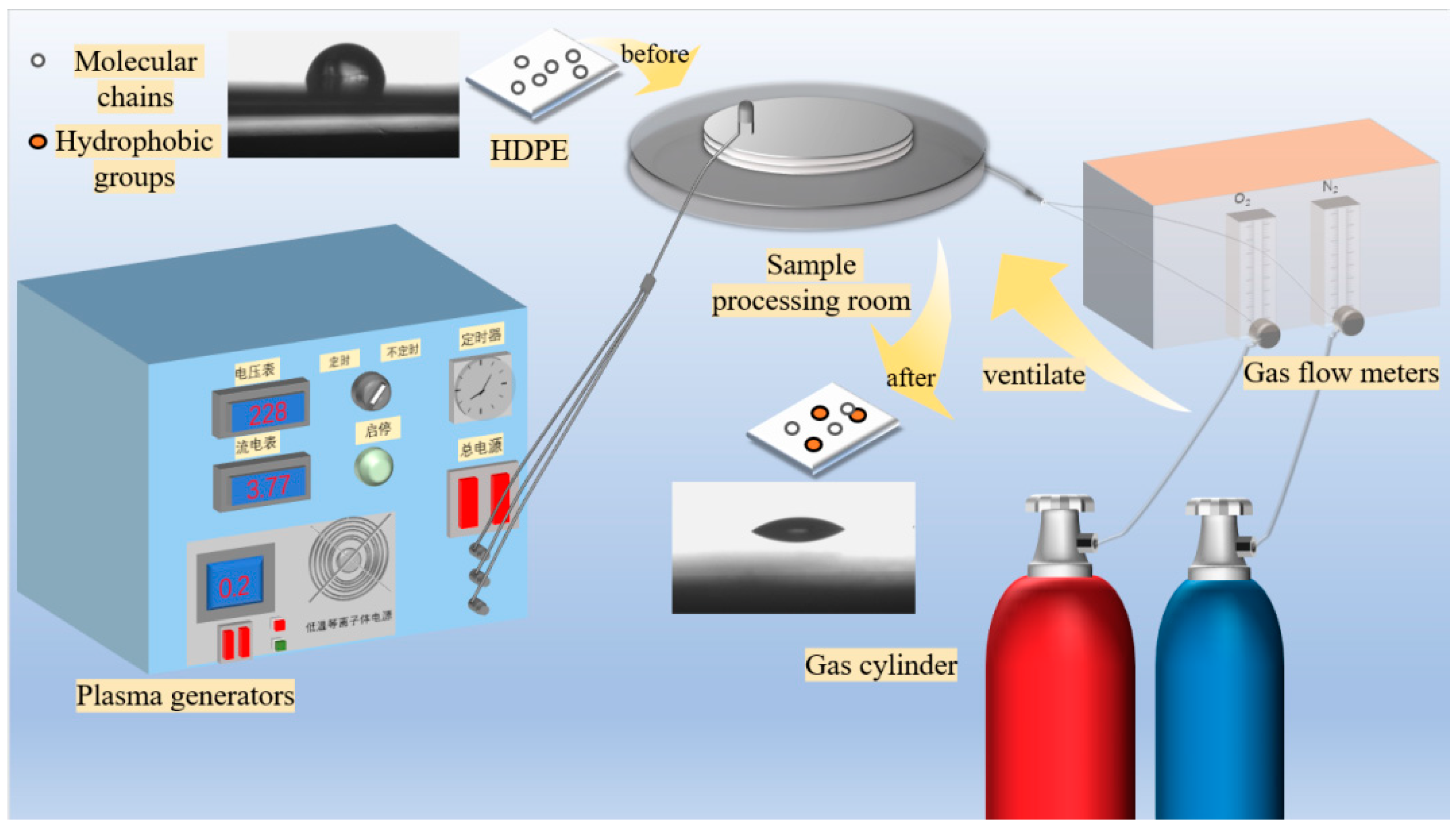
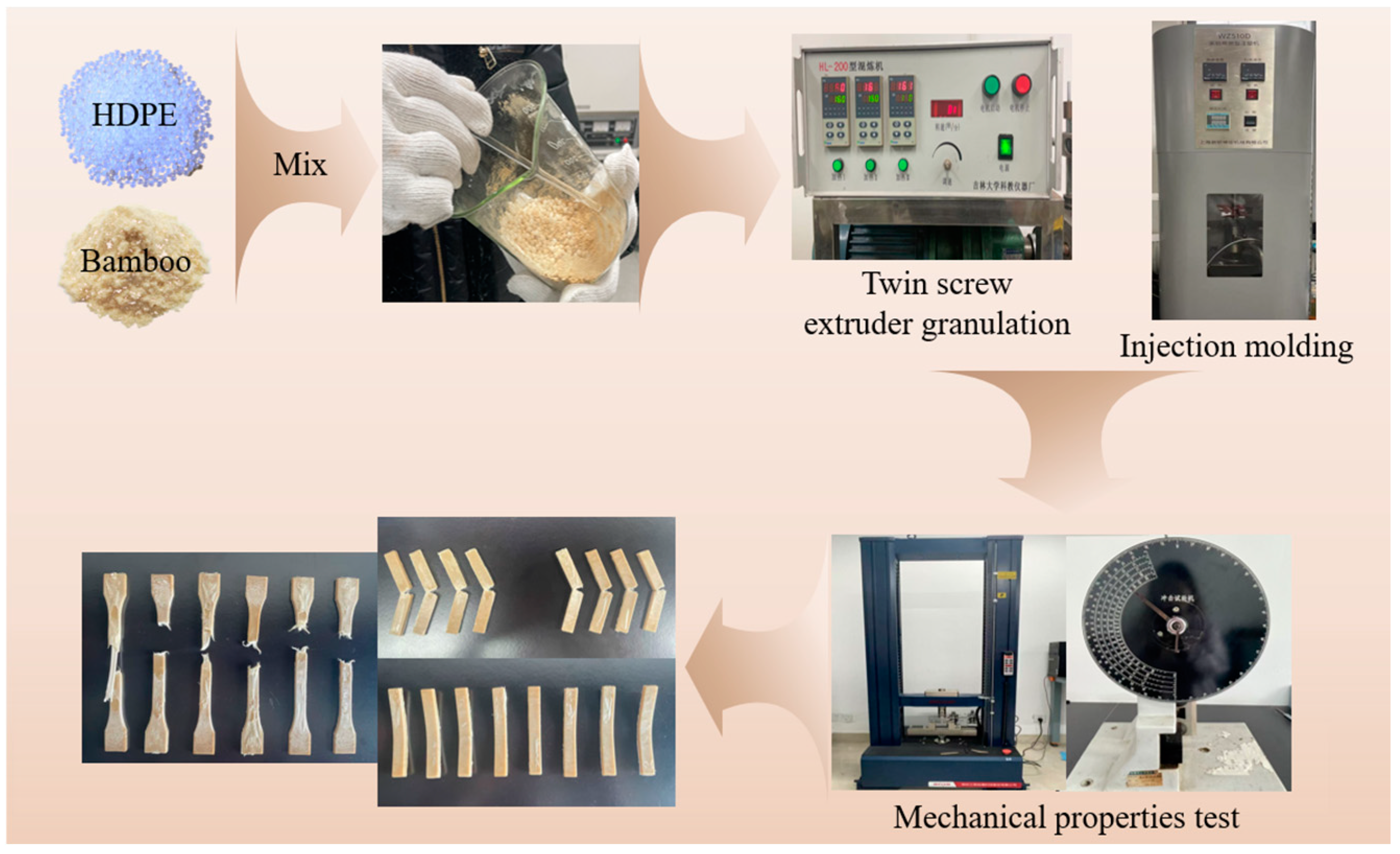
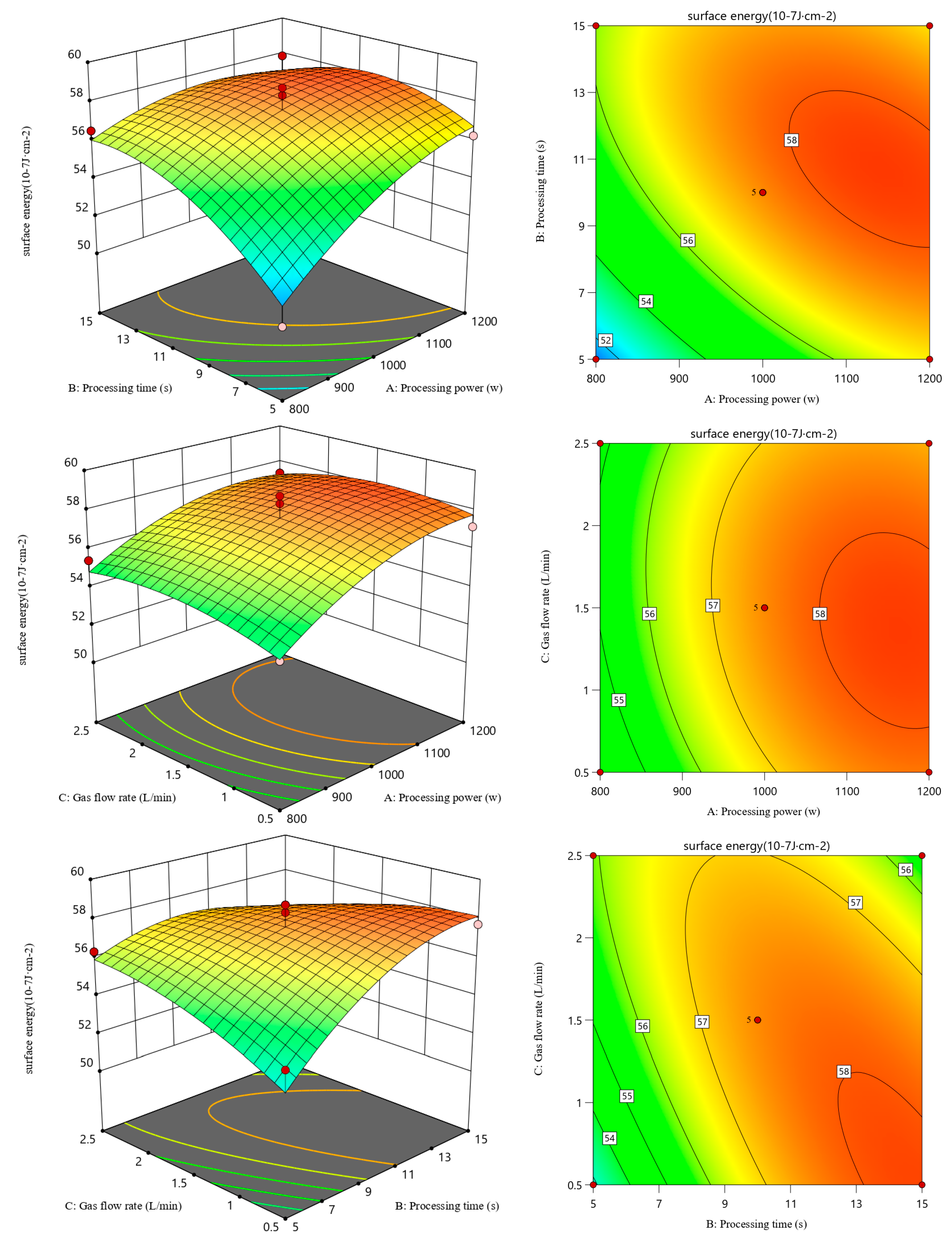







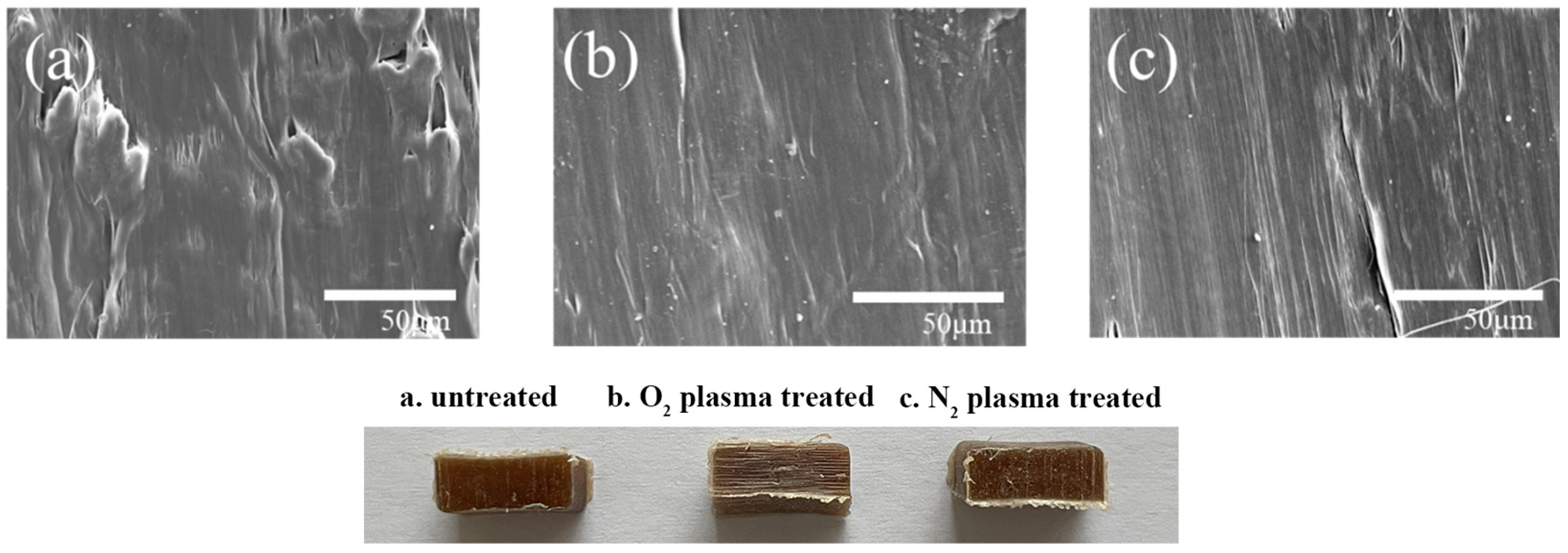
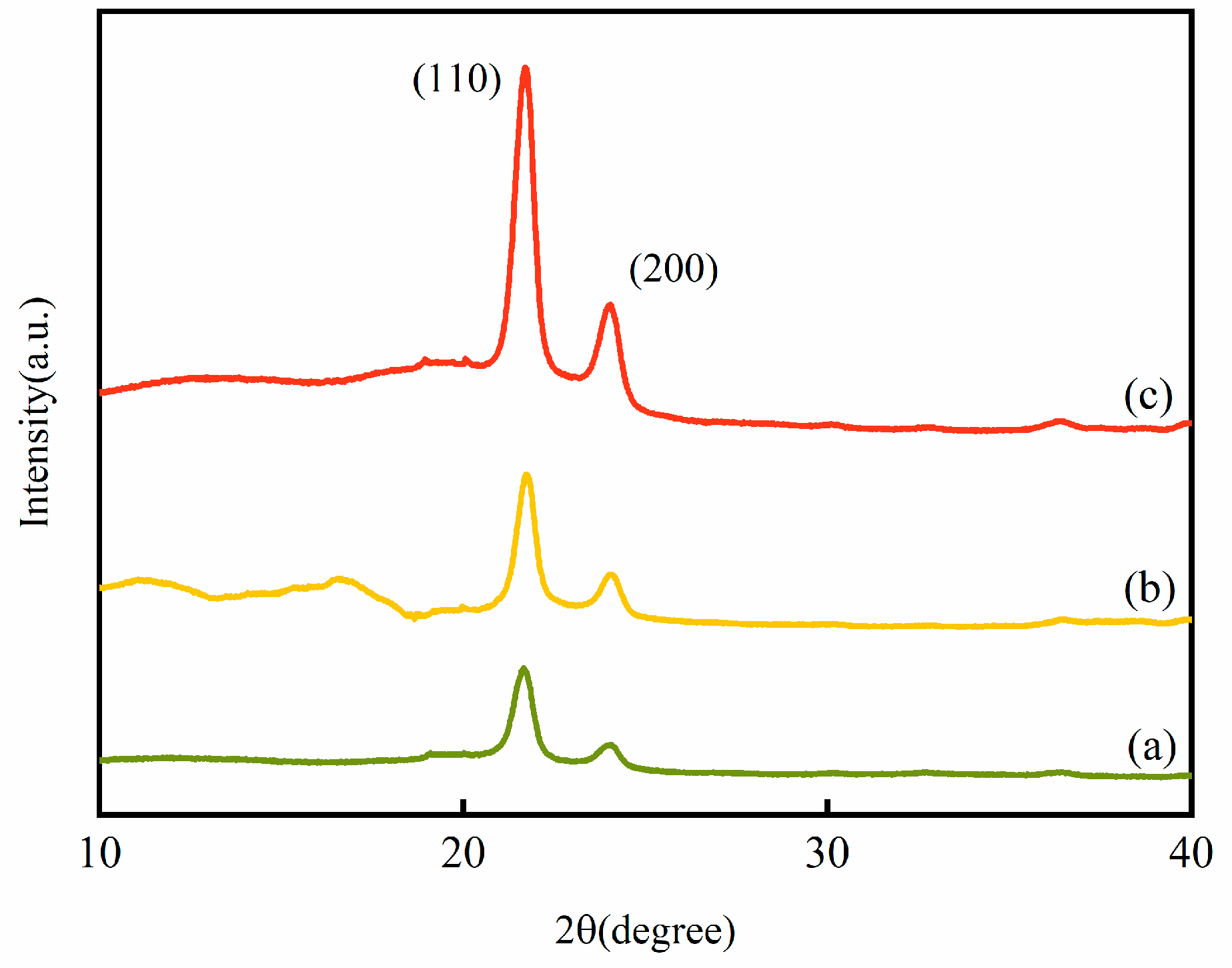


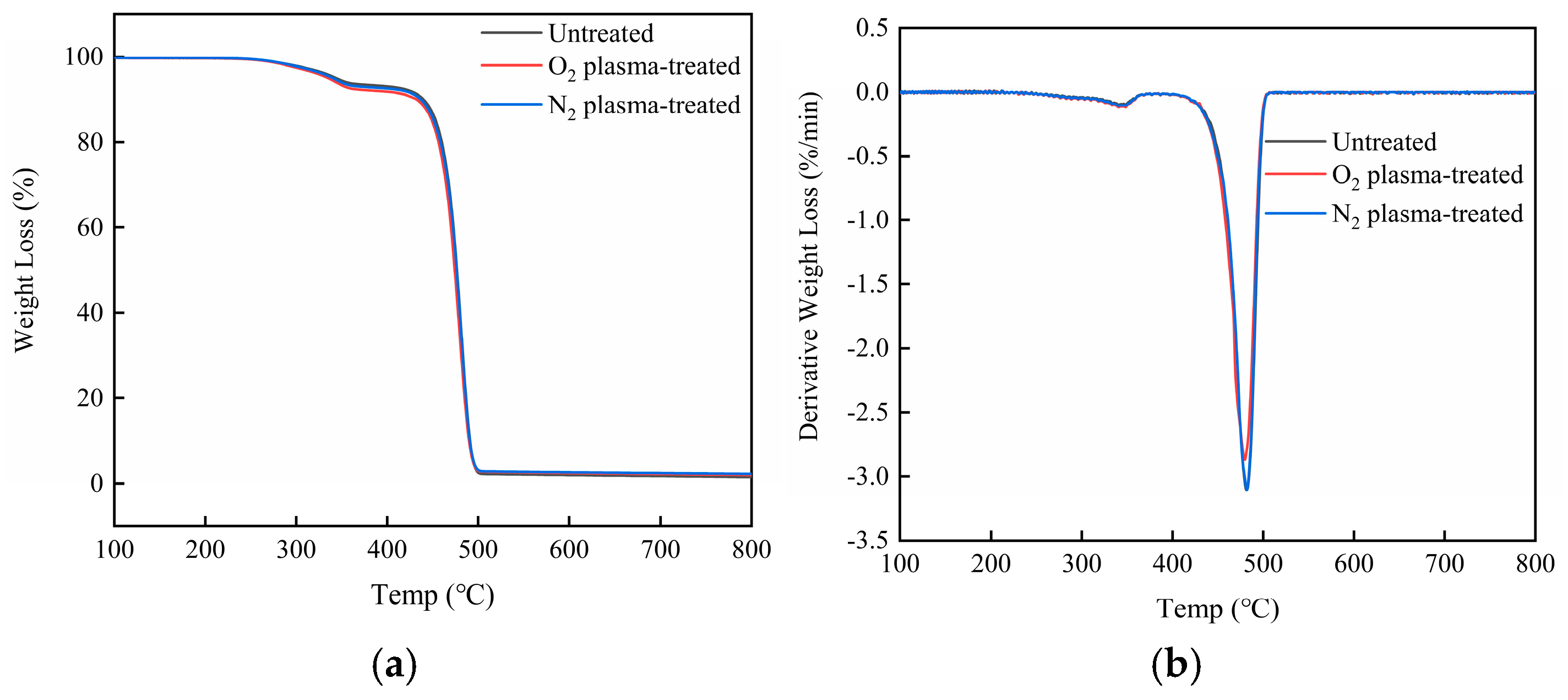

| Sample | Treatment Power (W) | Treatment Time (s) | Gas Flow Rate (L/min) | Contact Angle | Surface Energy (10−7 J·cm−2) | |
|---|---|---|---|---|---|---|
| H2O | CH2I2 | |||||
| 1 | 1000 | 5 | 2.5 | 45.6 | 28.5 | 56.32 |
| 2 | 1200 | 5 | 1.5 | 47.9 | 27.62 | 56.26 |
| 3 | 1200 | 10 | 2.5 | 45.94 | 25.42 | 57.36 |
| 4 | 1000 | 15 | 2.5 | 48.38 | 28.81 | 54.33 |
| 5 | 1000 | 10 | 1.5 | 45.17 | 26.69 | 58.33 |
| 6 | 800 | 5 | 1.5 | 51.11 | 35.95 | 50.36 |
| 7 | 800 | 15 | 1.5 | 47.25 | 28.1 | 56.51 |
| 8 | 1000 | 10 | 1.5 | 44.16 | 21.05 | 57.46 |
| 9 | 1000 | 5 | 0.5 | 52.43 | 27.6 | 53.95 |
| 10 | 800 | 10 | 2.5 | 49.1 | 28.7 | 55.42 |
| 11 | 1000 | 10 | 1.5 | 46.99 | 29.78 | 56.33 |
| 12 | 800 | 10 | 0.5 | 47.27 | 29 | 53.95 |
| 13 | 1200 | 10 | 0.5 | 46.52 | 26.58 | 57.16 |
| 14 | 1000 | 10 | 1.5 | 44.52 | 27.24 | 57.12 |
| 15 | 1000 | 15 | 0.5 | 45.7 | 25.91 | 57.73 |
| 16 | 1200 | 15 | 1.5 | 44.86 | 27.62 | 57.87 |
| 17 | 1000 | 10 | 1.5 | 44.78 | 22.91 | 58.72 |
| Sample | Treatment Power (W) | Treatment Time (s) | Gas Flow Rate (L/min) | Contact Angle | Surface Energy (10−7 J·cm−2) | |
|---|---|---|---|---|---|---|
| H2O | CH2I2 | |||||
| 1 | 1000 | 10 | 1.5 | 44.96 | 27.91 | 57.78 |
| 2 | 1000 | 15 | 0.5 | 51.41 | 29.84 | 53.98 |
| 3 | 1000 | 10 | 1.5 | 42.94 | 28.04 | 58.83 |
| 4 | 1000 | 5 | 0.5 | 49.56 | 28.16 | 55.29 |
| 5 | 1200 | 10 | 2.5 | 30.55 | 23.96 | 65.78 |
| 6 | 1000 | 5 | 2.5 | 36.48 | 23.1 | 62.97 |
| 7 | 1000 | 15 | 2.5 | 32.21 | 21.53 | 65.28 |
| 8 | 800 | 5 | 1.5 | 46.78 | 35.51 | 55.32 |
| 9 | 1200 | 10 | 0.5 | 44.78 | 31.59 | 57.19 |
| 10 | 800 | 10 | 2.5 | 31.09 | 22.87 | 65.66 |
| 11 | 800 | 15 | 1.5 | 41.89 | 32.08 | 58.71 |
| 12 | 1000 | 10 | 1.5 | 40.78 | 29.73 | 59.61 |
| 13 | 1200 | 5 | 1.5 | 45 | 36.82 | 56.09 |
| 14 | 1200 | 15 | 1.5 | 38.05 | 27.1 | 61.59 |
| 15 | 800 | 10 | 0.5 | 43.68 | 33.13 | 57.52 |
| 16 | 1000 | 10 | 1.5 | 43.01 | 30.93 | 58.29 |
| 17 | 1000 | 10 | 1.5 | 41.01 | 33.93 | 58.89 |
| Source | Sum of Squares | df | Mean Square | F-Value | p-Value | Distinctiveness |
|---|---|---|---|---|---|---|
| Model | 59.61 | 9 | 6.62 | 4.85 | 0.0247 | significant |
| A | 19.25 | 1 | 19.25 | 14.09 | 0.0071 | |
| B | 11.42 | 1 | 11.42 | 8.36 | 0.0233 | |
| C | 0.0520 | 1 | 0.0520 | 0.0380 | 0.8509 | |
| AB | 5.16 | 1 | 5.16 | 3.78 | 0.0931 | |
| AC | 0.4018 | 1 | 0.4018 | 0.2941 | 0.6044 | |
| BC | 8.33 | 1 | 8.33 | 6.10 | 0.0429 | |
| A² | 4.00 | 1 | 4.00 | 2.93 | 0.1307 | |
| B² | 7.83 | 1 | 7.83 | 5.73 | 0.0479 | |
| C² | 1.75 | 1 | 1.75 | 1.28 | 0.2954 | |
| Residual | 9.56 | 7 | 1.37 | |||
| Lack of Fit | 5.92 | 3 | 1.97 | 2.17 | 0.2343 | not significant |
| Pure Error | 3.64 | 4 | 0.9101 | |||
| Cor Total | 69.17 | 16 |
| Fit Statistics | Value |
|---|---|
| Std. Dev. | 1.17 |
| Mean | 56.19 |
| C.V.% | 2.08 |
| R2 | 0.8617 |
| Adjusted R2 | 0.6840 |
| Predicted R2 | −0.4523 |
| Adeq. Precision | 7.5518 |
| Source | Sum of Squares | df | Mean Square | F-Value | p-Value | Distinctiveness |
|---|---|---|---|---|---|---|
| Model | 183.34 | 9 | 20.37 | 22.31 | 0.0002 | significant |
| A | 1.49 | 1 | 1.49 | 1.63 | 0.2418 | |
| B | 34.33 | 1 | 34.33 | 37.59 | 0.0005 | |
| C | 105.49 | 1 | 105.49 | 115.52 | <0.0001 | |
| AB | 1.11 | 1 | 1.11 | 1.22 | 0.3065 | |
| AC | 0.0517 | 1 | 0.0517 | 0.0566 | 0.8187 | |
| BC | 2.33 | 1 | 2.33 | 2.55 | 0.1546 | |
| A² | 0.0740 | 1 | 0.0740 | 0.0810 | 0.7842 | |
| B² | 1.62 | 1 | 1.62 | 1.77 | 0.2249 | |
| C² | 37.63 | 1 | 37.63 | 41.21 | 0.0004 | |
| Residual | 6.39 | 7 | 0.9132 | |||
| Lack of Fit | 4.49 | 3 | 1.50 | 3.15 | 0.1483 | not significant |
| Pure Error | 1.90 | 4 | 0.4752 | |||
| Cor Total | 189.73 | 16 |
| Fit Statistics | Value |
|---|---|
| Std. Dev. | 0.9556 |
| Mean | 59.73 |
| C.V.% | 1.60 |
| R2 | 0.9663 |
| Adjusted R2 | 0.9230 |
| Predicted R2 | 0.6056 |
| Adeq. Precision | 15.5622 |
| Elements | Untreated | O2 | N2 |
|---|---|---|---|
| C | 97.69 | 74.99 | 80.13 |
| N | 0.52 | 3.01 | 2.86 |
| O | 1.79 | 22 | 17 |
| O/C | 0.02 | 0.29 | 0.21 |
| N/C | 0.005 | 0.04 | 0.04 |
| Sample | Residue (mg) | Weight Loss Rate (%) |
|---|---|---|
| Untreated | 0.0688 | 98.54 |
| a | 0.1033 | 98.0248 |
| b | 0.1356 | 97.7755 |
| Sample | Tc0 (°C) | Tc (°C) | Tm0 (°C) | Tm (°C) | ΔHc (J/g) | ΔHm (J/g) | Xc (%) |
|---|---|---|---|---|---|---|---|
| Untreated | 124.51 | 134.41 | 453.66 | 484.26 | 122.37 | 579.38 | 21.46 |
| a | 124.37 | 134.51 | 451.62 | 484.19 | 135.34 | 497.36 | 18.42 |
| b | 124.04 | 134.62 | 456.23 | 458.78 | 129.81 | 455.63 | 16.87 |
Disclaimer/Publisher’s Note: The statements, opinions and data contained in all publications are solely those of the individual author(s) and contributor(s) and not of MDPI and/or the editor(s). MDPI and/or the editor(s) disclaim responsibility for any injury to people or property resulting from any ideas, methods, instructions or products referred to in the content. |
© 2025 by the authors. Licensee MDPI, Basel, Switzerland. This article is an open access article distributed under the terms and conditions of the Creative Commons Attribution (CC BY) license (https://creativecommons.org/licenses/by/4.0/).
Share and Cite
Ma, Z.; Wu, Y.; Wang, H.; Zhang, J.; Yuan, S. The Effect of Plasma Treatment on the Mechanical Properties of HDPE/Bamboo Fiber Composites. Polymers 2025, 17, 983. https://doi.org/10.3390/polym17070983
Ma Z, Wu Y, Wang H, Zhang J, Yuan S. The Effect of Plasma Treatment on the Mechanical Properties of HDPE/Bamboo Fiber Composites. Polymers. 2025; 17(7):983. https://doi.org/10.3390/polym17070983
Chicago/Turabian StyleMa, Zihan, Yan Wu, Hongyan Wang, Jian Zhang, and Shaofei Yuan. 2025. "The Effect of Plasma Treatment on the Mechanical Properties of HDPE/Bamboo Fiber Composites" Polymers 17, no. 7: 983. https://doi.org/10.3390/polym17070983
APA StyleMa, Z., Wu, Y., Wang, H., Zhang, J., & Yuan, S. (2025). The Effect of Plasma Treatment on the Mechanical Properties of HDPE/Bamboo Fiber Composites. Polymers, 17(7), 983. https://doi.org/10.3390/polym17070983





